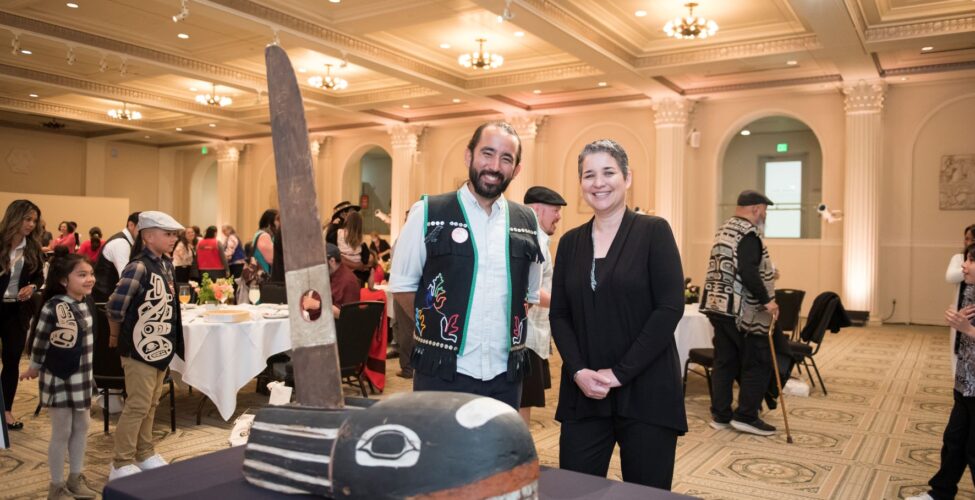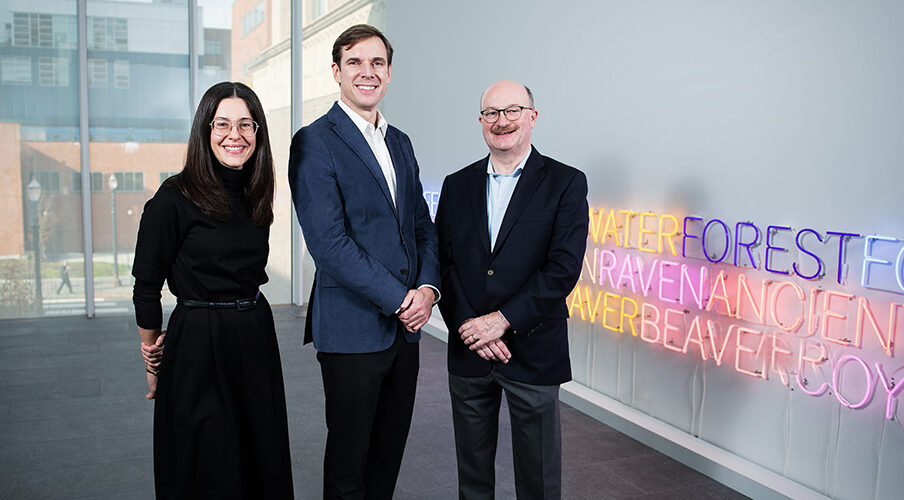The Museum and tribal leaders held a transfer ceremony in Portland before nine objects of cultural patrimony were repatriated to the Central Council of Tlingit & Haida Indian Tribes of Alaska.
Nine objects of cultural patrimony removed from Wrangell, Alaska, in the 1930s and 1940s are now back home in the hands of the Naanya.aayí clan, the Portland Art Museum and the Central Council of Tlingit & Haida Indian Tribes of Alaska announced this week. The The Museum and tribal leaders held a transfer ceremony in Portland in late May, and the repatriated objects—a Killerwhale Hat from the original Chief Shakes House Flotilla of Killerwhale Hats; Killerwhale Flotilla Chilkat Robe; Killerwhale Stranded on a Rock Robe; a Mudshark Hat; three Mudshark Shirts; Killerwhale with a Hole Fin; and the Storm Headdress—arrived in Juneau, Alaska, in early June.
Between 1921 and 1944, Axel Rasmussen, Superintendent of Schools in Wrangell, AK, and later in Skagway, AK, collected Native American art and cultural items primarily from the Tlingit communities he served and from dealers in the region. After his death in 1945, the collection was transferred to an art dealer and purchased by the Portland Art Museum in 1948.
In 2002, these nine cultural items were claimed by the Central Council of the Tlingit & Haida Indian Tribes on behalf of the Naanya.aayi clan and the Wrangell Cooperative Association under the Native American Graves Protection and Repatriation Act (NAGPRA). They belonged to the Naanya.aayi clan and were kept in their clan house (known as the “Shakes House”) under the custody of the hereditary clan leader, Chief Shakes, over multiple generations. The cultural items have ongoing historical, traditional, and cultural importance that is central to the Tlingit clan structure.
NAGPRA, a federal law, exists to return human remains, associated or disassociated funerary objects, sacred/ceremonial objects, and objects of cultural patrimony. Cultural patrimony includes “objects possessing continuing cultural, traditional, or historical importance to the heritage of a group, particularly those considered inalienable by the group as of the time the objects had been separated from the group or from the historical setting of the objects.”
The claim was approved by the Portland Art Museum in 2019. After delays caused by COVID-19, the objects were formally deaccessioned from the Museum’s collection and repatriated to the Tlingit & Haida.
On May 27, a closed ceremony was held at the Portland Art Museum with Tlingit lineal descendants, clan leaders of the Wrangell Kiks.ádi and Teeyhítaan clans, Tlingit & Haida representatives and museum staff to clear a path home for the objects. A reception followed and was attended by additional museum staff, trustees, and local Native American community leaders and representatives.
Luella Knapp of the Naanya.aayí clan and a member of the Wrangell Cooperative Association is caretaker of some clan objects and shared, “We are so grateful for all of the work that was done to return the Naanya.aayí clan’s atóow. As a caretaker of these clan items, it is an honor. Receiving them back, one by one, brings back the spirit of the person who wore them. We are so happy to have them returned to Wrangell’s Naanya.aayí.”
“The Tribe shares its deep passion and commitment to support our clans—today the Naanya.aayí—to bring our ancestors home,” said Tlingit & Haida’s Chief Operating Officer Roald Helgesen. “Háw’aa, Gunalchéesh to the Portland Art Museum for their recent efforts to repatriate our ancestors. Our clans and our people know our ancestors through song and story. Reuniting our ancestors with our people is a humbling honor.”
“This is a landmark occasion, too long in the making,” said Portland Art Museum Director Brian Ferriso. “Although museums continue to try to do the correct thing and be on the right side of history in fulfilling their mission, sometimes mistakes are made and it is essential for the wrongs of the past to be made right. That is what we are attempting to do with the return of these works.”
Ferriso, who has headed the Portland Art Museum since 2006, has emphasized building stronger and more collaborative relationships with the Indigenous communities represented in the museum’s Native American Art collection, with increased focus on making progress addressing outstanding repatriation claims.
“Stewardship is not just about storage and exhibitions—it is also about our relationships with communities,” continued Ferriso. “We are honored to take this important step with our partners in the Tlingit communities, and we look forward to working together in future discussions.”
Kathleen Ash-Milby, who is a member of the Navajo Nation, has been the Curator of Native American Art for the Portland Art Museum since 2019. She stated that repatriation was one of her top priorities when she took the position.
“I am grateful that times have changed and the museum is committed to moving in the right direction with this first repatriation to the Tlingit by the Portland Art Museum,” Ash-Milby said.
“By returning these ancestral objects to their communities, we can begin to repair a complicated history between Indigenous people and museums. It has been an honor to help with the final steps of this repatriation and see these ancestors finally swim home.”



